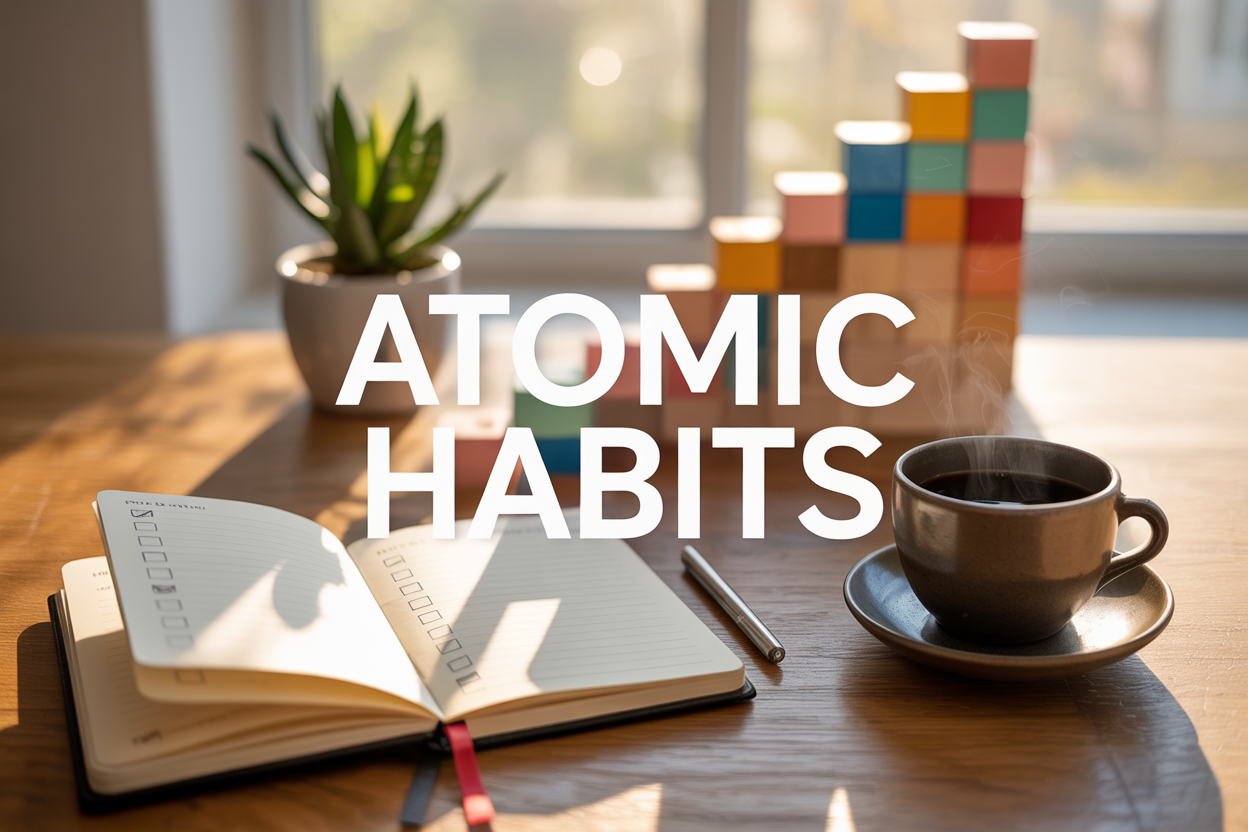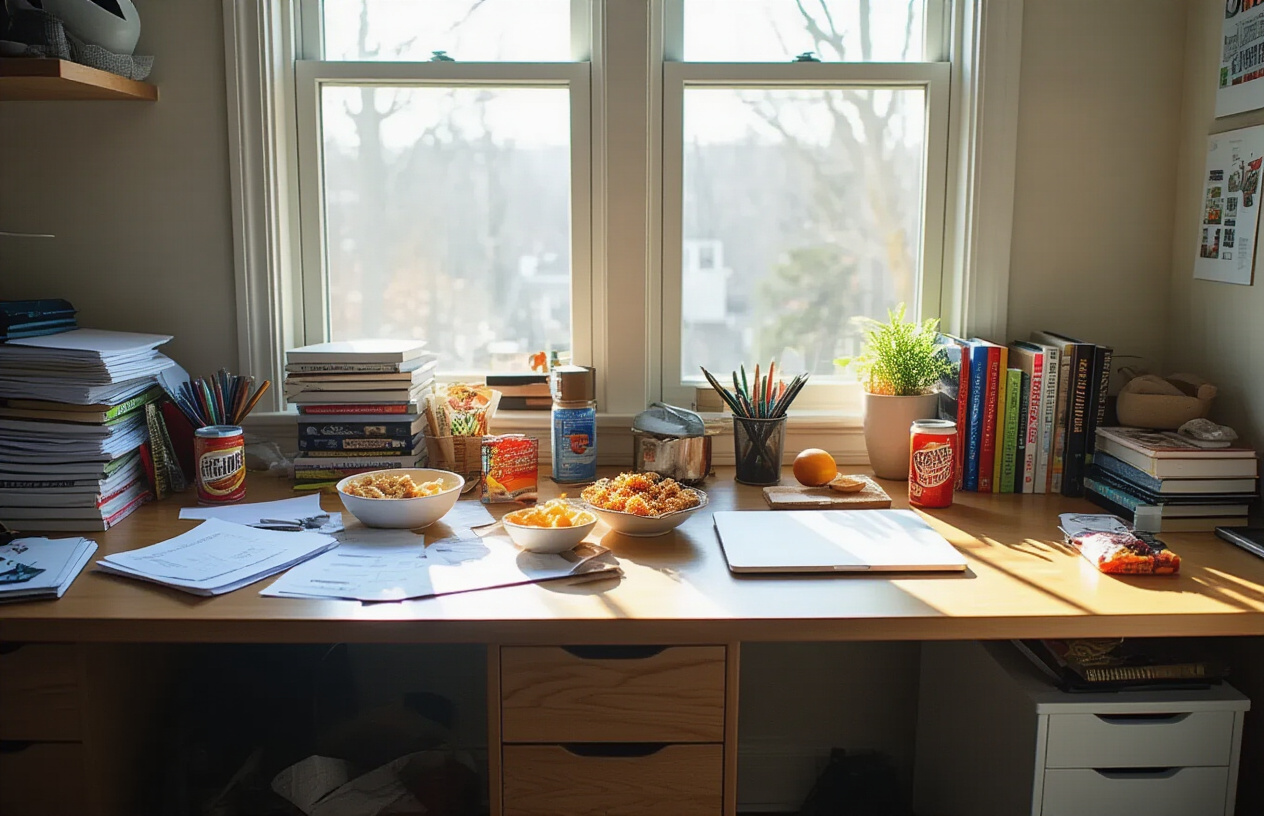Atomic Habits Summary: Key Lessons That Can Transform Your Life

Small changes create massive results. James Clear's "Atomic Habits" proves that tiny daily improvements compound into life-changing transformations over months and years.
This Atomic Habits summary is perfect for busy professionals, students, and anyone who wants to build better habits without overwhelming their schedule. You'll discover practical strategies that work even when motivation fades.
We'll break down Clear's Four Laws of Behavior Change that make good habits stick and bad ones disappear. You'll also learn why focusing on identity over outcomes creates lasting change, and how simple environment tweaks can make healthy choices automatic. Plus, we'll explore the Two-Minute Rule that turns any habit into something you can start today.
Ready to turn small actions into big wins? Let's dive into the key lessons that can rewire your daily routine for success.


The Four Laws of Behavior Change That Drive Success

Make it obvious by designing clear environmental cues
Your environment speaks to you constantly, whispering suggestions about what to do next. James Clear emphasizes that the most effective way to build habits is to make the cues for good habits incredibly visible while hiding the cues for bad ones. Think about placing your workout clothes next to your bed, keeping healthy snacks at eye level in your fridge, or putting your guitar in the middle of your living room.
The key lies in understanding that your brain is always scanning for environmental signals. When you walk into a room, your subconscious mind immediately catalogs what's available and primes you for certain behaviors. A cluttered kitchen counter might trigger mindless snacking, while a clean workspace with a notebook and pen suggests it's time to write.
Clear introduces the concept of "implementation intentions" - specific plans that dictate when and where you'll perform a habit. Instead of saying "I'll exercise more," you commit to "I'll do pushups in my bedroom immediately after I brush my teeth in the morning." This precision eliminates decision fatigue and creates automatic behavioral triggers.
Make it attractive through temptation bundling and social proof
Humans are wired to pursue what feels good, and Clear shows how to hack this natural tendency. Temptation bundling pairs an action you need to do with something you want to do. Want to catch up on your favorite Netflix series? Only watch it while doing cardio at the gym. Love scrolling through Instagram? Only do it while walking on the treadmill.
Social proof acts as a powerful motivator because we naturally mirror the behaviors of people around us. Join communities where your desired behavior is the norm - surround yourself with runners if you want to run, writers if you want to write, or entrepreneurs if you want to start a business. When everyone around you is doing something, it stops feeling difficult and starts feeling normal.
The brain's reward system can be trained to anticipate pleasure from good habits. Create anticipation by building small rituals before your habits. Light a candle before meditation, play energizing music before workouts, or brew your favorite tea before reading. These pre-habit rituals signal to your brain that something enjoyable is about to happen.
Make it easy by reducing friction and starting small
Friction is the enemy of good habits. Clear advocates for the "path of least resistance" - making good habits so easy that you can't say no. Prepare tomorrow's healthy lunch today, lay out your running clothes the night before, or keep a water bottle at your desk. Every small barrier you remove increases the likelihood you'll follow through.
The two-minute rule transforms intimidating goals into manageable actions. Instead of "read for 30 minutes," start with "read one page." Instead of "do a full workout," begin with "put on gym clothes." Once you're in motion, continuing becomes much easier than starting from zero.
Habit stacking leverages existing routines as triggers for new behaviors. After I pour my morning coffee, I'll write in my journal. After I sit down for lunch, I'll text one friend. After I put on my pajamas, I'll place tomorrow's clothes on the chair. This creates a chain of behaviors where each action naturally leads to the next.
Make it satisfying with immediate rewards and tracking
Your brain craves immediate gratification, but most good habits deliver rewards weeks or months later. Bridge this gap by creating instant satisfaction. Transfer $5 to your vacation fund after each workout, enjoy a piece of dark chocolate after completing a work session, or watch a funny video after cleaning for 15 minutes.
Habit tracking provides visual proof of your progress and creates its own reward loop. Seeing a chain of X's on a calendar or watching a streak counter grow triggers the same satisfaction as completing the habit itself. Use simple tracking methods - a journal, phone app, or wall calendar work perfectly.
The "never miss twice" rule acknowledges that perfection isn't the goal; consistency is. When you slip up, get back on track immediately. One missed workout doesn't ruin your fitness goals, but two missed workouts starts a pattern. Focus on systems that help you bounce back quickly rather than systems that demand perfection.
Identity-Based Habits Beat Outcome-Focused Goals

Shift from what you want to who you wish to become
Most people approach habits backwards. They focus on what they want to achieve rather than who they want to become. The difference is profound and game-changing.
When you chase outcomes, you're essentially asking yourself: "What do I want?" But identity-based habits flip this question: "Who do I want to be?" This shift transforms everything about how you approach change.
Consider two people trying to quit smoking. Person A says, "I'm trying to quit smoking" when offered a cigarette. Person B says, "I'm not a smoker." The first person still identifies as a smoker who's temporarily abstaining. The second has already shifted their identity.
Your identity acts like a North Star for your behavior. When you see yourself as an athlete, you naturally gravitate toward healthy choices. When you identify as a reader, picking up a book feels automatic rather than forced.
| Outcome-Based Approach | Identity-Based Approach |
|---|---|
| "I want to lose 20 pounds" | "I want to become someone who takes care of their body" |
| "I want to write a book" | "I want to become a writer" |
| "I want to learn Spanish" | "I want to become someone who speaks Spanish" |
The identity-first approach creates lasting change because it addresses the root cause of your behavior patterns.
Use habits to vote for your desired identity
Every action you take is a vote for the type of person you want to become. This voting system runs constantly in the background of your life, and the results determine your identity.
Each time you write a single paragraph, you vote for "writer." Each time you put on your running shoes, you vote for "athlete." Each time you choose water over soda, you vote for "healthy person."
The beautiful thing about this voting system is that you don't need a perfect record to win the election. You just need a majority. Missing one workout doesn't make you lazy. Skipping one meditation session doesn't mean you're not mindful. What matters is winning more votes than you lose.
This perspective removes the all-or-nothing pressure that derails so many people. Bad days become single lost votes rather than complete failures. You can bounce back immediately by casting your next vote in the right direction.
The key is being intentional about which identity you're voting for. Ask yourself: "What would a healthy person do right now?" Then do that thing, however small it might be.
Build evidence through small consistent wins
Your brain believes what you show it through evidence, not what you tell it through wishful thinking. Small consistent actions create an evidence file that proves your new identity to yourself.
Want to become a reader? Read one page daily. That's 365 pages of evidence by year's end. Want to become fit? Do five push-ups every morning. That's 1,825 push-ups proving your commitment to fitness.
These micro-actions might seem insignificant, but they serve as identity anchors. Each small win reinforces your belief in your new identity and makes the next action easier to take.
Start ridiculously small:
Writers write one sentence
Meditators sit quietly for two minutes
Runners put on their shoes
Healthy eaters drink one extra glass of water
The size of the action matters less than the consistency of showing up. Your brain doesn't distinguish between big and small evidence - it just counts the frequency of proof.
As your evidence file grows thicker, your confidence in your new identity strengthens. What once required willpower becomes automatic. You stop trying to be someone different and start being who you already are.
The Compound Effect of Small Daily Improvements

Focus on getting 1% better each day
James Clear's most powerful insight revolves around the magic of marginal gains. Instead of chasing dramatic transformations, the real power lies in tiny, consistent improvements. When you get just 1% better each day, you're 37 times better by the end of the year. That's the math behind exponential growth.
Think about it this way: if you read just two pages of a book daily, you'll finish 12-15 books per year. If you do five push-ups today and add one more each week, you'll be doing 57 push-ups by year-end. These micro-improvements seem insignificant in the moment, but they compound into remarkable results.
The beauty of 1% improvements is that they're sustainable. Your brain doesn't resist small changes the way it fights against massive overhauls. When you commit to writing one sentence instead of a whole chapter, or walking for five minutes instead of an hour, you bypass the mental resistance that kills most ambitious plans.
Daily 1% Improvement Examples:
| Area | Small Daily Action | Annual Result |
|---|---|---|
| Reading | 2 pages | 12-15 books |
| Fitness | 5 minutes exercise | 30+ hours of activity |
| Learning | 1 new word | 365 vocabulary words |
| Relationships | 1 meaningful text | Stronger connections |
Understand why habits plateau and breakthrough
The plateau effect frustrates most people into quitting, but it's actually where the real magic happens. Your habits follow a pattern: initial excitement, gradual progress, then what feels like stagnation. This isn't failure - it's the natural cycle of skill development.
Picture an ice cube sitting in a room at 25 degrees. You heat the room to 26, 27, 28 degrees - nothing happens. The ice remains solid. But at 32 degrees, it suddenly melts. The previous heating wasn't wasted; it was essential preparation for the breakthrough moment.
Your habits work the same way. You might practice guitar for months without feeling like you're improving, then suddenly you can play that difficult song. You might eat healthy and exercise for weeks without seeing weight loss, then drop five pounds in one week. The plateau isn't proof that your system is broken - it's proof that breakthrough is coming.
Common Plateau Patterns:
Weeks 1-4: Motivation high, results visible
Weeks 5-12: Progress slows, doubt creeps in
Weeks 13+: Breakthrough moments begin appearing
Trust the process during the valley of disappointment
The valley of disappointment is that brutal period where your efforts feel pointless. You're putting in work but seeing no visible results. Clear calls this the most dangerous phase because this is where most people quit, often just before their breakthrough.
Your expectations create this valley. You expect linear progress - work harder, get better results immediately. But real change happens like compound interest. The effects are minimal early on, then explode later. The key is trusting that your daily actions are building something powerful beneath the surface.
During this valley, focus on your systems rather than outcomes. Instead of asking "Am I losing weight?" ask "Did I stick to my eating plan today?" Instead of "Am I getting smarter?" ask "Did I read my daily pages?" The outcomes will come, but only if you stay consistent through the difficult middle period.
Strategies for the Valley:
Track your process, not just results
Celebrate small wins daily
Remember why you started
Find an accountability partner
Adjust your system, don't abandon it
The valley of disappointment isn't a bug in the system - it's a feature. It separates those who achieve lasting change from those who chase quick fixes. When you feel stuck, remember that bamboo grows underground for years before shooting up 90 feet in just six weeks. Your breakthrough is building right now.
Environment Design Shapes Your Behavior

Optimize your physical space for good habits
Your surroundings constantly influence your behavior, often without you realizing it. When you design your environment strategically, good habits become the path of least resistance. Place workout clothes next to your bed if you want to exercise in the morning. Keep healthy snacks at eye level in your fridge and pantry. Position books you want to read on your coffee table instead of hiding them on a shelf.
Your workspace matters just as much. If you want to drink more water, keep a large water bottle on your desk. Want to reduce screen time? Create a charging station outside your bedroom. The key is making the first step of your desired habit as easy as possible by removing any barriers between you and the action you want to take.
Remove triggers that lead to bad habits
Bad habits stick around because environmental cues keep triggering them. Your phone buzzing with notifications pulls you into endless scrolling. The cookies sitting on your kitchen counter tempt you every time you walk by. That comfortable spot on your couch where you always binge-watch Netflix makes it hard to be productive.
Start by identifying the environmental triggers that derail your progress. Then systematically remove or modify them. Delete social media apps from your phone. Store junk food in hard-to-reach places or better yet, don't buy it at all. Rearrange your living space so that problem areas don't constantly catch your attention.
Use visual cues to prompt desired behaviors
Visual reminders serve as powerful nudges toward positive actions. A guitar in the corner of your room reminds you to practice. Running shoes by the front door encourage daily walks. A filled water bottle on your desk prompts regular hydration.
Make these cues impossible to ignore by placing them in your direct line of sight. Use bright colors, sticky notes, or phone wallpapers to reinforce the behaviors you want to build. The more obvious the cue, the more likely you'll follow through on the habit.
Create friction for unwanted behaviors
While you want to make good habits easy, creating obstacles for bad habits helps break unwanted patterns. Unplug your TV and put the remote in another room if you watch too much. Log out of social media accounts and remove saved passwords. Keep your phone in a drawer during work hours instead of on your desk.
The goal isn't to make these behaviors impossible, just inconvenient enough that you pause before acting. This brief moment of friction gives you time to make a conscious choice rather than operating on autopilot. Even small barriers can dramatically reduce the frequency of unwanted behaviors.
The Two-Minute Rule and Habit Stacking

Start new habits with just two minutes
The Two-Minute Rule cuts through the biggest obstacle standing between you and consistent habits: overwhelm. Instead of committing to an hour at the gym or reading fifty pages daily, you focus on putting on your workout clothes or reading just one page. This approach works because it removes the mental friction that makes us procrastinate.
When you make a habit ridiculously easy to start, you eliminate excuses. Can't find thirty minutes to meditate? Try two minutes. Too tired to write a thousand words? Write one sentence. The magic happens when these tiny actions become automatic. Once you're already dressed for the gym, you'll often end up working out. After writing one sentence, you frequently continue writing more.
The rule operates on a simple principle: establishing the habit matters more than the performance. Your brain doesn't distinguish between a two-minute workout and a two-hour one when building neural pathways. Both actions reinforce your identity as someone who exercises regularly. The consistency creates the foundation, and the intensity can grow naturally over time.
Many people resist this approach because it feels too small to matter. They want dramatic changes and visible results immediately. But sustainable transformation happens through consistent small actions, not sporadic bursts of motivation. The Two-Minute Rule helps you show up every day, creating the momentum that eventually leads to lasting change.
Link new habits to existing routines
Habit stacking leverages your existing routines as launching pads for new behaviors. Since your current habits already have established neural pathways and strong cue-response patterns, they provide perfect triggers for new actions. The formula is simple: "After I [current habit], I will [new habit]."
This technique works because it eliminates the guesswork around when to perform your new habit. Instead of relying on time-based cues like "I'll exercise at 6 PM," which can easily be derailed by schedule changes, you anchor your new behavior to something you already do consistently. After you pour your morning coffee, you'll write three things you're grateful for. After you sit down for dinner, you'll ask each family member about their day.
The key to successful habit stacking lies in choosing the right anchor habit. Your existing habit should be highly consistent and occur around the same time you want to perform your new behavior. If you rarely eat breakfast at home, don't stack a new habit onto breakfast. Instead, find something you do religiously, like checking your phone first thing in the morning or brushing your teeth before bed.
You can also create habit chains by stacking multiple behaviors together. After putting on your running shoes, you'll step outside. After stepping outside, you'll start walking. After walking for two minutes, you'll begin jogging. Each action naturally leads to the next, creating powerful momentum that carries you through the entire sequence.
Build momentum through consistency over intensity
Consistency beats intensity every time when building lasting habits. While motivation gets you started, momentum keeps you going. The person who exercises for ten minutes daily will achieve more long-term success than someone who works out intensely for two hours once a week. Regular repetition creates stronger neural pathways and makes the behavior feel natural and effortless.
Momentum works like compound interest for habits. Each day you show up, you're not just performing the action—you're reinforcing your identity and making tomorrow's repetition easier. Missing one day doesn't derail your progress, but missing two days starts to weaken the momentum. Missing three days can require significant effort to restart.
The power of momentum becomes clear when you consider how habits feel at different stages. Initially, new behaviors require conscious effort and decision-making. After consistent repetition, they become automatic responses that require minimal willpower. This automation frees up mental energy for other activities and makes the habit feel effortless rather than burdensome.
Building momentum also creates positive feedback loops. When you consistently follow through on small commitments to yourself, you develop confidence in your ability to change. This self-trust makes it easier to tackle bigger challenges and stick with habits during difficult periods. The person who successfully maintains a two-minute daily habit develops the same mental muscles needed for more demanding behaviors later.
Smart habit builders focus on maintaining their streak rather than maximizing individual performances. They understand that showing up consistently, even when they don't feel like it, builds the foundation for long-term transformation. Perfect days are less important than persistent days.

Small changes really can transform your entire life when you understand the science behind how habits work. The four laws of behavior change give you a clear roadmap for building good habits and breaking bad ones, while focusing on your identity rather than just outcomes creates lasting change from the inside out. When you design your environment to support your goals and use simple techniques like the two-minute rule and habit stacking, you're setting yourself up for automatic success.
The beauty of atomic habits lies in their simplicity and compound effect. You don't need massive willpower or dramatic life overhauls to see real results. Start with one tiny habit today, make it part of who you are, and watch how those small daily improvements add up to remarkable transformations over time. Your future self will thank you for taking that first small step.